Low-Temperature and Low-Pressure Silicon Nitride Deposition by ECR-PECVD for Optical Waveguides
Abstract
1. Introduction
2. Fabrication
2.1. Silicon Nitride Thin-Film Deposition
2.2. Annealing
3. Characterization and Results
3.1. Refractive Index and Thickness
3.2. Optical Loss
3.3. Surface Roughness
3.4. Stoichiometry
4. Conclusion
Author Contributions
Funding
Institutional Review Board Statement
Informed Consent Statement
Data Availability Statement
Acknowledgments
Conflicts of Interest
References
- Bauters, J.F.; Heck, M.J.R.; John, D.; Dai, D.; Tien, M.; Barton, J.S.; Liense, A.; Heideman, R.G.; Blumenthal, D.J.; Bowers, J.E. Ultra-low-loss high-aspect-ratio Si3N4 waveguides. Opt. Express 2011, 19, 3163. [Google Scholar] [CrossRef]
- Bucio, T.D.; Khokhar, A.Z.; Lacava, C.; Stankovic, S.; Mashanovich, G.Z.; Petropoulos, P.; Gardes, F.Y. Material and optical properties of low-temperature NH3 -free PECVD SiNx layers for photonic applications. J. Phys. D Appl. Phys. 2017, 50, 025106. [Google Scholar] [CrossRef]
- Blumenthal, D.J.; Heideman, R.G.; Geuzebroek, D.; Leinse, A.; Roeloffzen, C. Silicon Nitride in Silicon Photonics. Proc. IEEE 2018, 106, 2209–2231. [Google Scholar] [CrossRef]
- Gorin, A.; Jaouad, A.; Grondin, E.; Aimez, V.; Charette, P. Fabrication of silicon nitride waveguides for visible-light using PECVD: A study of the effect of plasma frequency on optical properties. Opt. Express 2008, 16, 13509–13516. [Google Scholar] [CrossRef] [PubMed]
- Gonzalvez, J.; Luna, R.; Tudanca, M.; Sánchez, O.; Albella, J.; Martinez-Duart, J. Plasma-enhanced chemically vapour deposited Si3N4 thin films for optical waveguides. Thin Solid Films 1992, 220, 311–314. [Google Scholar] [CrossRef]
- Barrios, C.A.; Sánchez, B.; Gylfason, K.B.; Griol, A.; Sohlström, H.; Holgado, M.; Casquel, R. Demonstration of slot-waveguide structures on silicon nitride / silicon oxide platform. Opt. Express 2007, 15, 6846. [Google Scholar] [CrossRef] [PubMed]
- Muñoz, P.; Micó, G.; Bru, L.; Pastor, D.; Pérez, D.; Doménech, J.; Fernández, J.; Baños, R.; Gargallo, B.; Alemany, R.; et al. Silicon nitride photonic integration platforms for visible, near-infrared and mid-infrared applications. Sensors 2017, 17, 2088. [Google Scholar] [CrossRef]
- Hosseini, E.S.; Yegnanarayanan, S.; Atabaki, A.H.; Soltani, M.; Adibi, A. High quality planar silicon nitride microdisk resonators for integrated photonics in the visible wavelength range. Opt. Express 2009, 17, 14543–14551. [Google Scholar] [CrossRef] [PubMed]
- Goykhman, I.; Desiatov, B.; Levy, U. Ultrathin silicon nitride microring resonator for biophotonic applications at 970 nm wavelength. Appl. Phys. Lett. 2010, 97, 30–32. [Google Scholar] [CrossRef]
- Khan, S.A.; Shi, Y.; Chang, C.-M.; Jan, C.; Fan, S.; Ellerbee, A.K.; Solgaard, O. Optical separation of heterogeneous size distributions of microparticles on silicon nitride strip waveguides. Opt. Express 2015, 23, 8855–8866. [Google Scholar] [CrossRef] [PubMed]
- Gaugiran, S.; Gétin, S.; Fedeli, J.M.; Colas, G.; Fuchs, A.H.; Chatelain, F.; Dérouard, J. Optical manipulation of microparticles and cells on silicon nitride waveguides. Opt. Express 2005, 13, 6956–6963. [Google Scholar] [CrossRef] [PubMed]
- Sharma, S.K.; Barthwal, S.; Singh, V.; Society, A.E.; Kumar, A. PECVD based silicon oxynitride thin films for nano photonic on chip interconnects applications PECVD based silicon oxynitride thin films for nano photonic on chip interconnects applications. Micron 2012, 44, 339–346. [Google Scholar] [CrossRef]
- Yota, J.; Hander, J.; Saleh, A.A. A comparative study on inductively-coupled plasma high-density plasma, plasma-enhanced, and low pressure chemical vapor deposition silicon nitride films. J. Vac. Sci. Technol. A 2000, 18, 372–376. [Google Scholar] [CrossRef]
- Dabos, G.; Manolis, A.; Giesecke, A.; Porschatis, C.; Chmielak, B.; Wahlbrink, T.; Pleros, N.; Tsiokos, D. TM grating coupler on low-loss LPCVD based Si3N4 waveguide platform. Opt. Commun. 2017, 405, 35–38. [Google Scholar] [CrossRef]
- Krückel, C.J.; Fülöp, A.; Ye, Z.; Andrekson, P.A.; Torres-Company, V. Optical bandgap engineering in nonlinear silicon nitride waveguides. Opt. Express 2017, 25, 15370–15380. [Google Scholar] [CrossRef] [PubMed]
- Subramanian, A.; Neutens, P.; Dhakal, A.; Jansen, R.; Claes, T.; Rottenberg, X.; Peyskens, F.; Selvaraja, S.K.; Helin, P.; Du Bois, B.; et al. Low-Loss Singlemode PECVD Silicon Nitride Photonic Wire Waveguides for 532–900 nm Wavelength Window Fabricated Within a CMOS Pilot Line. IEEE Photon J. 2013, 5, 2202809. [Google Scholar] [CrossRef]
- Chiles, J.; Nader, N.; Hickstein, D.D.; Yu, S.P.; Briles, T.C.; Carlson, D.; Jung, H.; Shainline, J.M.; Diddams, S.; Papp, S.B.; et al. Deuterated silicon nitride photonic devices for broadband optical frequency comb generation. Opt. Lett. 2018, 43, 1527–1530. [Google Scholar] [CrossRef] [PubMed]
- Dergez, D.; Schalko, J.; Bittner, A.; Schmid, U. Fundamental properties of a-SiNx:H thin films deposited by ICP-PECVD for MEMS applications. Appl. Surf. Sci. 2013, 284, 348–353. [Google Scholar] [CrossRef]
- Kshirsagar, A.; Nyaupane, P.; Bodas, D.; Duttagupta, S.; Gangal, S. Deposition and characterization of low temperature silicon nitride films deposited by inductively coupled plasma CVD. Appl. Surf. Sci. 2011, 257, 5052–5058. [Google Scholar] [CrossRef]
- Charifi, H.; Slaoui, A.; Stoquert, J.P.; Chaib, H.; Hannour, A. Opto-Structural Properties of Silicon Nitride Thin Films Deposited by ECR-PECVD. World J. Condens. Matter Phys. 2016, 6, 7–16. [Google Scholar] [CrossRef]
- Wu, A.M.; Yue, H.Y.; Zhang, X.; Qin, F.W.; Li, T.; Jiang, X. Synthesis and Its Characteristic of Silicon Nitride Film Deposited by ECR-PECVD at Low Temperature. Mater. Sci. Forum 2010, 654–656, 1712–1715. [Google Scholar] [CrossRef]
- Keita, A.-S.; Naciri, A.E.; Delachat, F.; Carrada, M.; Ferblantier, G.; Slaoui, A. Dielectric functions of Si nanoparticles within a silicon nitride matrix. Phys. Status Solidi C 2010, 7, 418–422. [Google Scholar] [CrossRef]
- Bosco, G.B.F.; Khatami, Z.; Wojcik, J.; Mascher, P.; Tessler, L.R. Excitation mechanism of Tb3+ in a- Si3N4:H under sub-gap excitation. J. Lumin. 2018, 202, 327–331. [Google Scholar] [CrossRef]
- Ortiz-Santos, A.; Ramos, C.; Sastré-Hernández, J.; Santana, G.; Dutt, A.; Ortiz-Santos, A.; Ramos, C.; Sastré-Hernández, J.; Santana, G.; Dutt, A. White electroluminescence from SiNx thin films by a PECVD equipment using dichlorosilane precursor and study of emission mechanism. Mater. Technol. 2019, 35, 1–8. [Google Scholar] [CrossRef]
- Hiraki, T.; Aihara, T.; Nishi, H.; Tsuchizawa, T. Deuterated SiN/SiON Waveguides on Si Platform and Their Application to C-Band WDM Filters. IEEE Photon J. 2017, 9, 1–7. [Google Scholar] [CrossRef]
- Yamada, K.; Tsuchizawa, T.; Nishi, H.; Kou, R.; Hiraki, T.; Takeda, K.; Fukuda, H.; Ishikawa, Y.; Wada, K.; Yamamoto, T. High-performance silicon photonics technology for telecommunications applications. Sci. Technol. Adv. Mater. 2014, 15, 24603. [Google Scholar] [CrossRef]
- Wright, D.N.; Marstein, E.S.; Holt, A. Effect of annealing on PECVD silicon nitride films. In Proceedings of the 22nd European Photovoltaic Solar Energy Conference, Milan, Italy, 3–7 September 2007. [Google Scholar]
- Esposito, E.M.; Mercaldo, L.V.; Veneri, P.D.; Lancellotti, L.; Privato, C. Annealing effects on PECVD-grown Si rich aSiNx thin films. Energy Procedia 2010, 2, 159–164. [Google Scholar] [CrossRef]
- Bakardjieva, V.; Beshkov, G.; Vitanov, P.; Alexieva, Z. Effect of rapid thermal annealing on the properties of μPCVD and PECVD silicon nitride thin films. J. Optoelectron. Adv. Mater. 2005, 7, 377–380. [Google Scholar]
- Ay, F.; Aydinli, A. Comparative investigation of hydrogen bonding in silicon based PECVD grown dielectrics for optical waveguides. Opt. Mater. 2004, 26, 33–36. [Google Scholar]
- Dabkowski, R.P. Installation of a New Electron Cyclotron Plasma Enhanced Chemical Vapour Deposition (ECR-PECVD) Reactor and a Preliminary Study of Thin Film Depositions. Master’s Thesis, McMaster University, Hamilton, ON, Canada, 2011. [Google Scholar]
- Miller, J.; Khatami, Z.; Wojcik, J.; Bradley, J.; Mascher, P. Integrated ECR-PECVD and magnetron sputtering system for rare-earth-doped Si-based materials. Surf. Coatings Technol. 2018, 336, 99–105. [Google Scholar] [CrossRef]
- Wilson, P.R.; Roschuk, T.; Dunn, K.; Normand, E.N.; Chelomentsev, E.; Zalloum, O.H.; Wójcik, J.; Mascher, P. Effect of thermal treatment on the growth, structure and luminescence of nitride-passivated silicon nanoclusters. Nanoscale Res. Lett. 2011, 6, 168. [Google Scholar] [CrossRef] [PubMed]
- Wörhoff, K.; Driessen, A.; Lambeck, P.; Hilderink, L.; Linders, P.; Popma, T. Plasma enhanced chemical vapor deposition silicon oxynitride optimized for application in integrated optics. Sens. Actuators A Phys. 1999, 74, 9–12. [Google Scholar] [CrossRef]
- Criado, D.; Pereyra, I.; Alayo, M.I. Study of nitrogren-rich silicon oxynitride films obtained by PECVD. Mater. Charact. 2003, 50, 161–171. [Google Scholar] [CrossRef]
- Lide, D.R. (Ed.) CRC Handbook of Chemistry and Physics; CRC Press LLC: Boca Raton, FL, USA, 2004; Volume 85. [Google Scholar]
- Alayo, M.; Pereyra, I.; Scopel, W.; Fantini, M. On the nitrogen and oxygen incorporation in plasma-enhanced chemical vapor deposition (PECVD) SiOxNy films. Thin Solid Films 2002, 402, 154–161. [Google Scholar] [CrossRef]
- Hussein, M.; Worhoff, K.; Sengo, G.; Driessen, A. Optimization of plasma-enhanced chemical vapor deposition silicon oxynitride layers for integrated optics applications. Thin Solid Films 2007, 515, 3779–3786. [Google Scholar] [CrossRef]
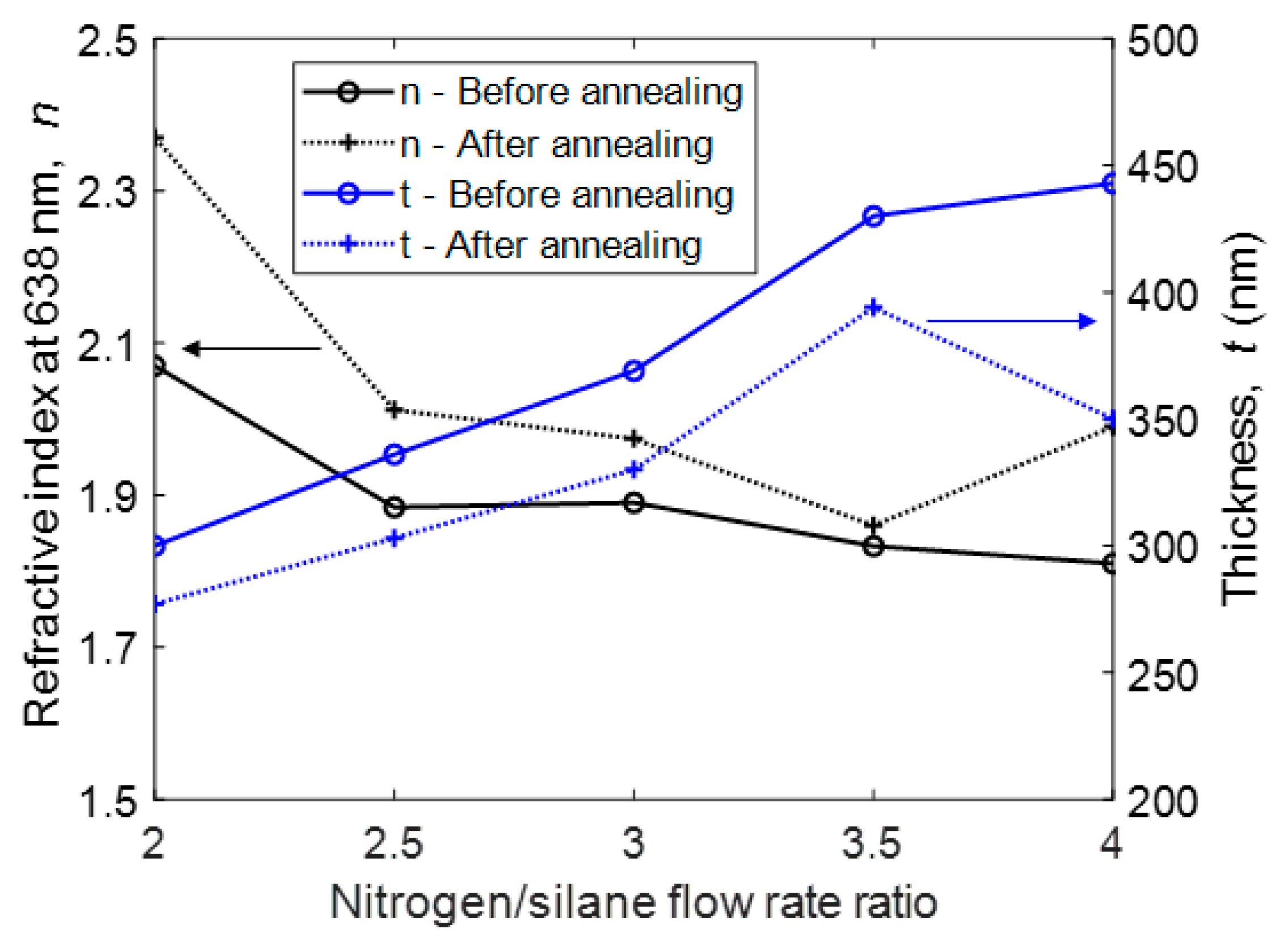
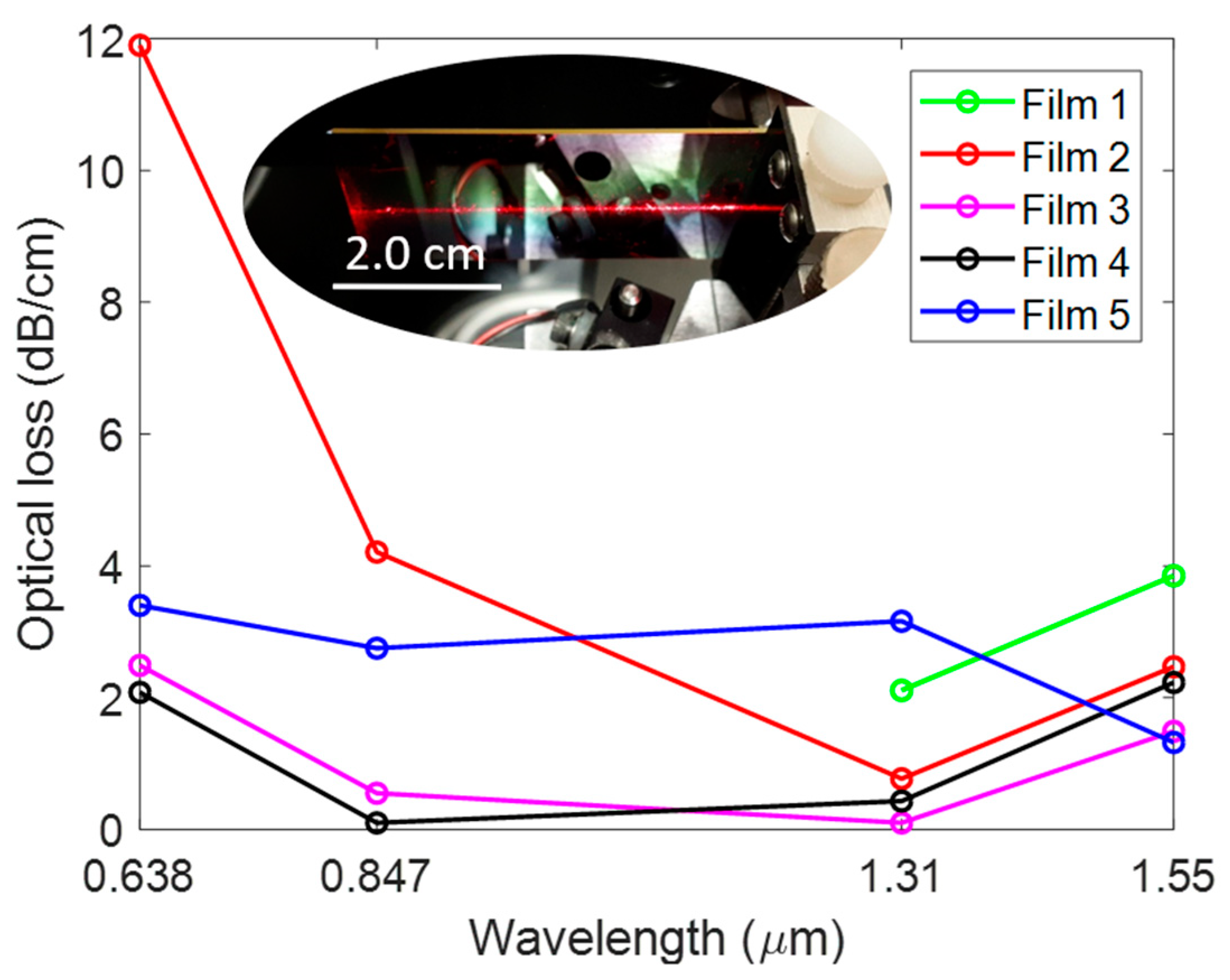
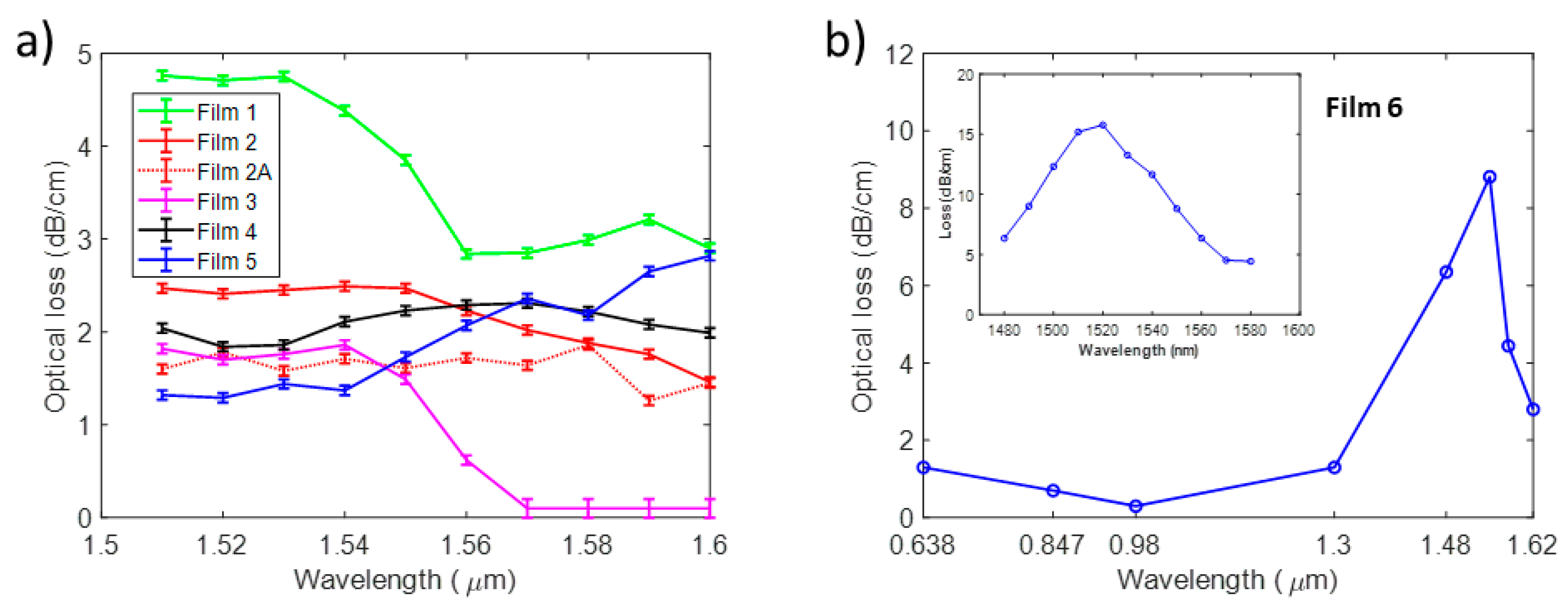
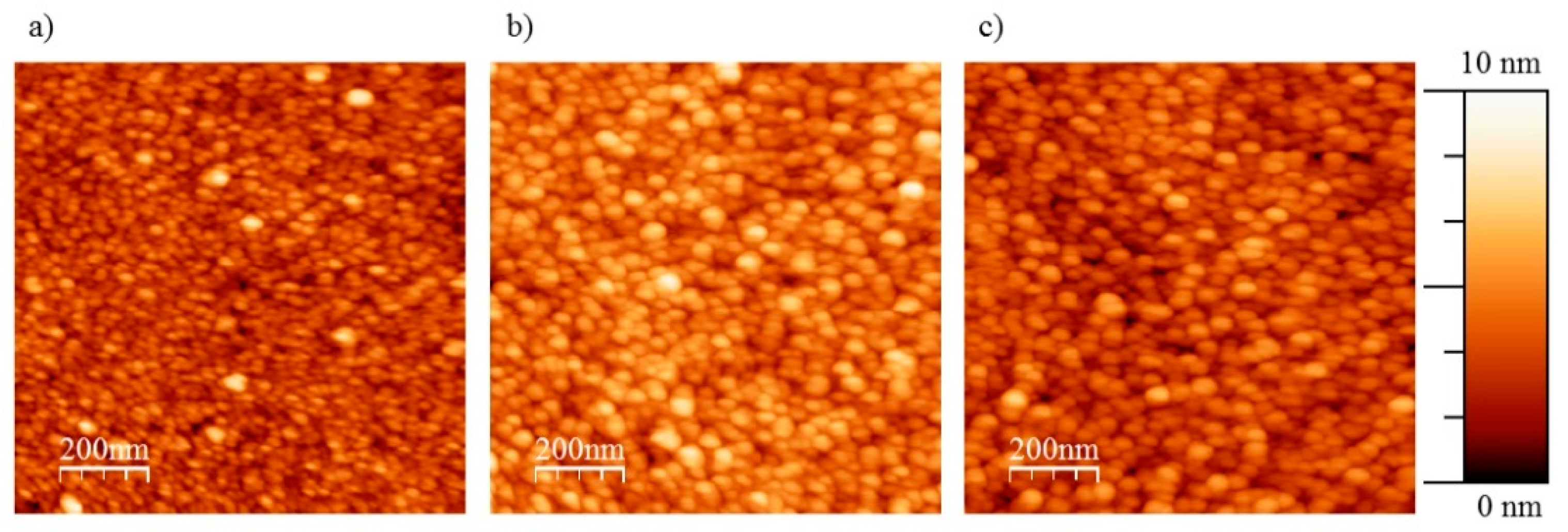
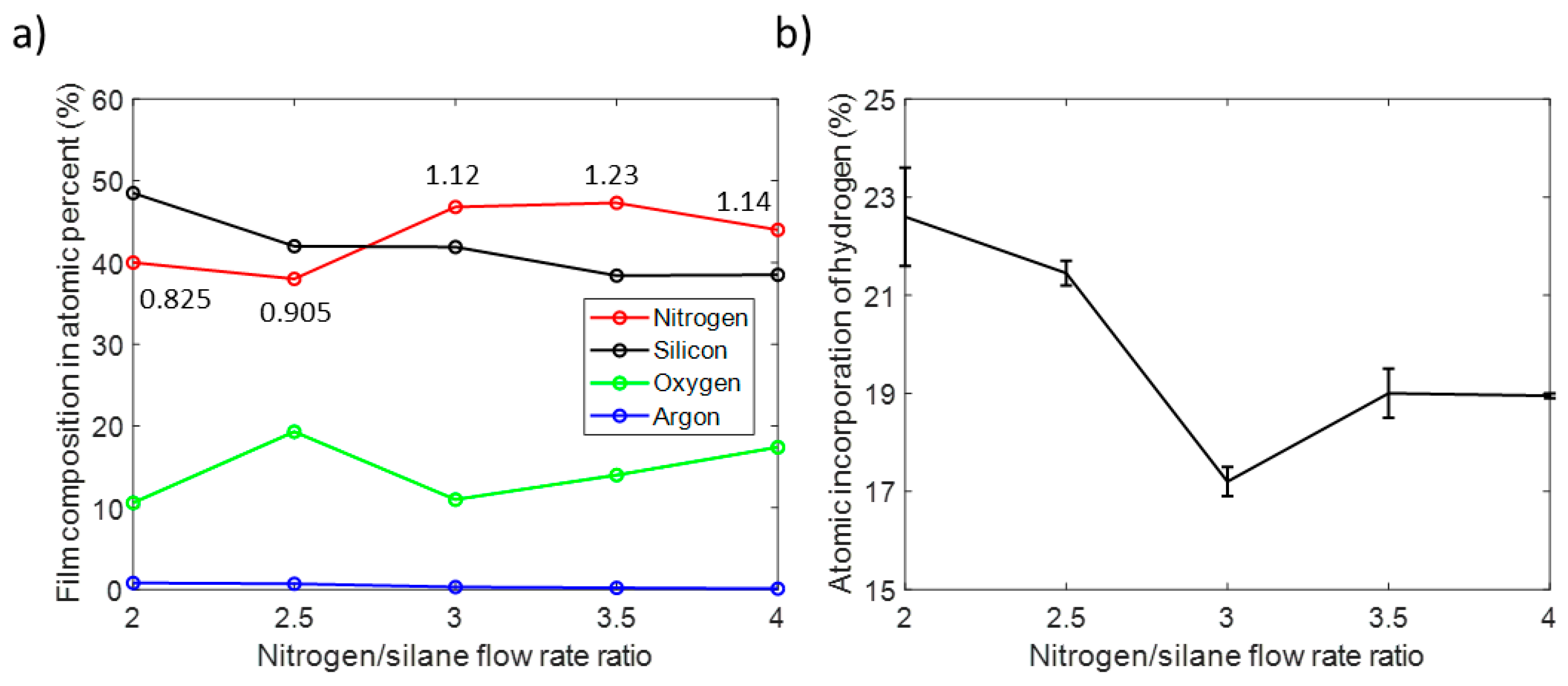
| Deposition Parameters | Film 1 | Film 2 | Film 3 | Film 4 | Film 5 | Film 6 |
|---|---|---|---|---|---|---|
| N2/Ar (10/90%) flow rate (sccm) | 10.0 | 12.5 | 15.0 | 17.5 | 20.0 | 15.0 |
| SiH4/Ar (30/70%) flow rate (sccm) | 5.0 | 5.0 | 5.0 | 5.0 | 5.0 | 5.0 |
| N2/Ar partial pressure—round 1(mTorr) | 1.15 | 1.40 | 1.64 | 1.83 | 2.10 | 1.63 |
| N2/Ar partial pressure—round 2 (mTorr) | 1.18 | 1.43 | 1.62 | 1.87 | 2.09 | N/A |
| SiH4/Ar partial pressure—round 1 (mTorr) | 1.60 | 1.79 | 2.01 | 2.24 | 2.45 | 2.02 |
| SiH4/Ar partial pressure—round 2 (mTorr) | 1.62 | 1.81 | 1.98 | 2.24 | 2.49 | N/A |
| Pre-deposition pressure—round 1 (Torr) | 9.5 × 10−8 | 8.0 × 10−8 | 4.8 × 10−8 | 5.6 × 10−8 | 1.6 × 10−7 | 7.5 × 10−7 |
| Pre-deposition pressure—round 2 (Torr) | 2.2 × 10−8 | 1.1 × 10−7 | 7.5 × 10−8 | 7.0 × 10−8 | 8.5 × 10−8 | N/A |
| Deposition time for round 1 (min) | 210 | 210 | 210 | 210 | 210 | 380 |
| Deposition time for round 2 (min) | 90 | 90 | 90 | 90 | 90 | N/A |
| Temperature (°C) | 140 | 140 | 140 | 140 | 140 | 140 |
| Film # | 2, Annealed | 3, As-Deposited | 3, Annealed |
|---|---|---|---|
| RMS roughness (nm) | 0.95 ± 0.01 | 1.10 ± 0.01 | 1.01 ± 0.05 |
| Peak–peak amplitude (nm) | 9.55 ± 0.16 | 9.58 ± 0.12 | 7.93 ± 0.38 |
Publisher’s Note: MDPI stays neutral with regard to jurisdictional claims in published maps and institutional affiliations. |
© 2021 by the authors. Licensee MDPI, Basel, Switzerland. This article is an open access article distributed under the terms and conditions of the Creative Commons Attribution (CC BY) license (http://creativecommons.org/licenses/by/4.0/).
Share and Cite
Bonneville, D.B.; Miller, J.W.; Smyth, C.; Mascher, P.; Bradley, J.D.B. Low-Temperature and Low-Pressure Silicon Nitride Deposition by ECR-PECVD for Optical Waveguides. Appl. Sci. 2021, 11, 2110. https://doi.org/10.3390/app11052110
Bonneville DB, Miller JW, Smyth C, Mascher P, Bradley JDB. Low-Temperature and Low-Pressure Silicon Nitride Deposition by ECR-PECVD for Optical Waveguides. Applied Sciences. 2021; 11(5):2110. https://doi.org/10.3390/app11052110
Chicago/Turabian StyleBonneville, Dawson B., Jeremy W. Miller, Caitlin Smyth, Peter Mascher, and Jonathan D. B. Bradley. 2021. "Low-Temperature and Low-Pressure Silicon Nitride Deposition by ECR-PECVD for Optical Waveguides" Applied Sciences 11, no. 5: 2110. https://doi.org/10.3390/app11052110
APA StyleBonneville, D. B., Miller, J. W., Smyth, C., Mascher, P., & Bradley, J. D. B. (2021). Low-Temperature and Low-Pressure Silicon Nitride Deposition by ECR-PECVD for Optical Waveguides. Applied Sciences, 11(5), 2110. https://doi.org/10.3390/app11052110







